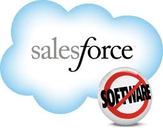
Recently, I’d been dealing with a couple of threads on Quora.com – One, was the ‘Open Source’ guys – open source ERP code is free, you just pay for someone to develop it to run in your business – a huge, horrific mistake in all cases. Two, was someone asking ‘Why Salesforce doesn’t have an ERP?’ One reply wittily stated ‘Why doesn’t Nike sell applesauce?’ which I thought was pretty funny.
But seriously, if you don’t realize the difference between CRM and ERP – and I once had a client who didn’t – the results can be disastrous.
So I posted the following answer to “Why doesn’t Salesforce have an ERP?’
Here’s why it never did and never could work.
Sales
Business Office
The Board of Directors
Then the auditors come in. Last year’s totals don’t match – you can’t ‘close’ a period in SFDC, anyone can go in and change anything for any reason. (many had the security clearance to do so). Accounting can’t tell why, who, when or where the changes were made. You can’t report to banks, VC guys, forget SOX.
Cause and Effect
In ERP financials, you don’t change fields. You issue a credit memo to show a discount. You process a return invoice showing a refund. You see the sale of $500, a discount of $25 and a refund of $50 – and your reports are right. You then close the period so no one can go in and revise anything. These are processes normal to accountants and might as well be Chinese to salesguys.
And companies that try to develop one-off software? Think about that for a moment.
You may have a really talented business staff of 10 and 4 software developers.
Sage has 10,000 businesses using their ERP and hundreds of software developers.
You guys might have your 4 developers work on this for months, constantly improving and adding features….
Sage has been doing this since the ’80’s. That’s 600 developers times 35 years – and you’re what, 4 guys for the last 6 months? Really? You want to compete with those odds? Worse yet, you want to compete with your competitors using Sage ERP versus your version one amateur experiment?
Feel free to substitute Oracle for Sage or SAP or any one of hundreds of ERP publishers who are better at this than you or I will ever be – (don’t mean to be harsh, it’s a fact).
Besides, writing software is not the business you are in and if you had that particular skill set, you’d already be making a lot more money at a software firm.
End of story – the founder lost the $300m+ national company that he’d built from scratch over the last 10 years. The VC boys determined he didn’t have what it takes to remain as CEO. New team came in, CFO, VP Sales, Directors – all fired. Don’t know what happened to the SFDC developers they had on staff, but I’m sure they landed on their feet – pretty talented bunch.
But real quick. Let’s do a little ROI review before we close. Sure, my ill-fated client hired one SFDC developer at a time – but in the final days, they were paying $400k in developer salaries annually to avoid having to spend $30,000 a year in Netsuite/Acumatica fees (or any of a hundred other ERP solutions that would have worked better than SFDC with Quickbooks).
And that’s why Salesforce doesn’t have an ERP.
It’s also why rolling-your-own ERP, whether using Open Source, SFDC, (or whatever as a base) is a huge, horrible, terrible, catastrophic idea – unless of course you’ve got a great golden parachute and are looking to lose the entire company.
And I can’t know for certain if it’s true, but I suspect had my client called me in 6 months earlier, we’d have put in real ERP and they’d still have the company.
To avoid this and other obvious Enterprise Software mistakes, contact gh@genehammons.com.
